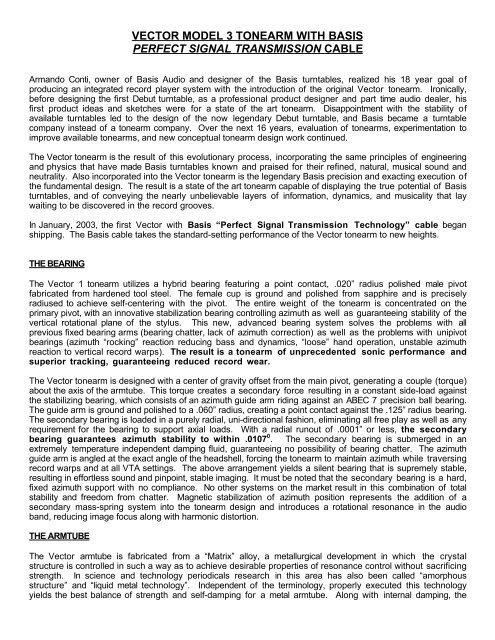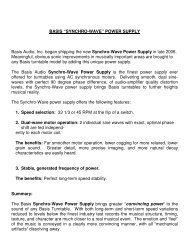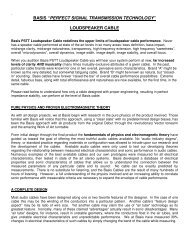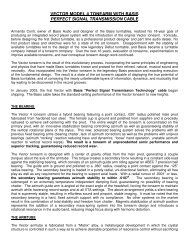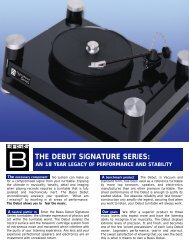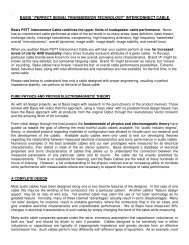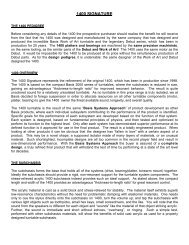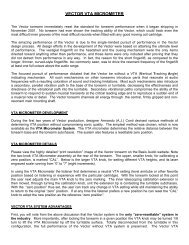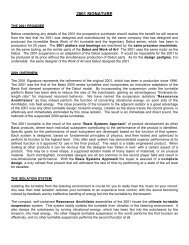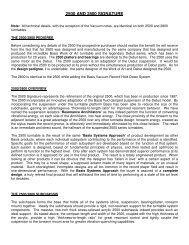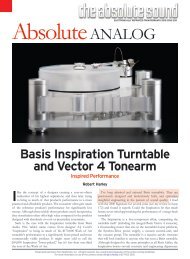vector model 3 tonearm with basis perfect signal ... - Basis Audio
vector model 3 tonearm with basis perfect signal ... - Basis Audio
vector model 3 tonearm with basis perfect signal ... - Basis Audio
Create successful ePaper yourself
Turn your PDF publications into a flip-book with our unique Google optimized e-Paper software.
VECTOR MODEL 3 TONEARM WITH BASISPERFECT SIGNAL TRANSMISSION CABLEArmando Conti, owner of <strong>Basis</strong> <strong>Audio</strong> and designer of the <strong>Basis</strong> turntables, realized his 18 year goal ofproducing an integrated record player system <strong>with</strong> the introduction of the original Vector <strong>tonearm</strong>. Ironically,before designing the first Debut turntable, as a professional product designer and part time audio dealer, hisfirst product ideas and sketches were for a state of the art <strong>tonearm</strong>. Disappointment <strong>with</strong> the stability ofavailable turntables led to the design of the now legendary Debut turntable, and <strong>Basis</strong> became a turntablecompany instead of a <strong>tonearm</strong> company. Over the next 16 years, evaluation of <strong>tonearm</strong>s, experimentation toimprove available <strong>tonearm</strong>s, and new conceptual <strong>tonearm</strong> design work continued.The Vector <strong>tonearm</strong> is the result of this evolutionary process, incorporating the same principles of engineeringand physics that have made <strong>Basis</strong> turntables known and praised for their refined, natural, musical sound andneutrality. Also incorporated into the Vector <strong>tonearm</strong> is the legendary <strong>Basis</strong> precision and exacting execution ofthe fundamental design. The result is a state of the art <strong>tonearm</strong> capable of displaying the true potential of <strong>Basis</strong>turntables, and of conveying the nearly unbelievable layers of information, dynamics, and musicality that laywaiting to be discovered in the record grooves.In January, 2003, the first Vector <strong>with</strong> <strong>Basis</strong> “Perfect Signal Transmission Technology” cable beganshipping. The <strong>Basis</strong> cable takes the standard-setting performance of the Vector <strong>tonearm</strong> to new heights.THE BEARINGThe Vector 1 <strong>tonearm</strong> utilizes a hybrid bearing featuring a point contact, .020” radius polished male pivotfabricated from hardened tool steel. The female cup is ground and polished from sapphire and is preciselyradiused to achieve self-centering <strong>with</strong> the pivot. The entire weight of the <strong>tonearm</strong> is concentrated on theprimary pivot, <strong>with</strong> an innovative stabilization bearing controlling azimuth as well as guaranteeing stability of thevertical rotational plane of the stylus. This new, advanced bearing system solves the problems <strong>with</strong> allprevious fixed bearing arms (bearing chatter, lack of azimuth correction) as well as the problems <strong>with</strong> unipivotbearings (azimuth “rocking” reaction reducing bass and dynamics, “loose” hand operation, unstable azimuthreaction to vertical record warps). The result is a <strong>tonearm</strong> of unprecedented sonic performance andsuperior tracking, guaranteeing reduced record wear.The Vector <strong>tonearm</strong> is designed <strong>with</strong> a center of gravity offset from the main pivot, generating a couple (torque)about the axis of the armtube. This torque creates a secondary force resulting in a constant side-load againstthe stabilizing bearing, which consists of an azimuth guide arm riding against an ABEC 7 precision ball bearing.The guide arm is ground and polished to a .060” radius, creating a point contact against the .125” radius bearing.The secondary bearing is loaded in a purely radial, uni-directional fashion, eliminating all free play as well as anyrequirement for the bearing to support axial loads. With a radial runout of .0001” or less, the secondarybearing guarantees azimuth stability to <strong>with</strong>in .0107 0 . The secondary bearing is submerged in anextremely temperature independent damping fluid, guaranteeing no possibility of bearing chatter. The azimuthguide arm is angled at the exact angle of the headshell, forcing the <strong>tonearm</strong> to maintain azimuth while traversingrecord warps and at all VTA settings. The above arrangement yields a silent bearing that is supremely stable,resulting in effortless sound and pinpoint, stable imaging. It must be noted that the secondary bearing is a hard,fixed azimuth support <strong>with</strong> no compliance. No other systems on the market result in this combination of totalstability and freedom from chatter. Magnetic stabilization of azimuth position represents the addition of asecondary mass-spring system into the <strong>tonearm</strong> design and introduces a rotational resonance in the audioband, reducing image focus along <strong>with</strong> harmonic distortion.THE ARMTUBEThe Vector armtube is fabricated from a “Matrix” alloy, a metallurgical development in which the crystalstructure is controlled in such a way as to achieve desirable properties of resonance control <strong>with</strong>out sacrificingstrength. In science and technology periodicals research in this area has also been called “amorphousstructure” and “liquid metal technology”. Independent of the terminology, properly executed this technologyyields the best balance of strength and self-damping for a metal armtube. Along <strong>with</strong> internal damping, the
Vector 3 armtube/headshell assembly form an inert platform for the cartridge to accurately retrieve the <strong>signal</strong>from the record.THE WIRINGIn design for two years, the <strong>Basis</strong> “Perfect Signal Transmission Technology” (PSST) phono cable follows thenormal <strong>Basis</strong> practice of starting <strong>with</strong> the basic physics. In the audio range, capacitance and inductance of acable changes radically as the frequency changes. Many listeners and audio industry professionalserroneously feel that higher frequency <strong>signal</strong> transmission poses greater problems than audio frequencytransmission. The reality of changing electrical properties <strong>with</strong> frequency in the audio range creates havoc<strong>with</strong> musical <strong>signal</strong>s. <strong>Audio</strong> range <strong>signal</strong>s are far more affected by phase distortion than <strong>signal</strong>s at higherfrequencies. The nature of the complex functions of impedance, capacitance, and inductance are asymptotic,stabilizing at extremely high frequencies, but substantially changing at audio frequencies. <strong>Basis</strong> solves thisproblem by employing “Distortionless Transmission Line Theory”, balancing cable properties to achieve thesingle set of conditions which will result in <strong>perfect</strong> <strong>signal</strong> transmission. The result is a phase coherent cablewhose sonic traits are those which one would expect from superior phase coherency: great clarity,seamlessness and an impression of sound sources “floating mid-air”, <strong>with</strong> the speakers “disappearing”.DAMPING SOLUTIONSIn <strong>model</strong>ing the behavior of the <strong>tonearm</strong>-cartridge system, Conti went back to the undeniable engineering basics.The compliance of all cartridge suspension systems, along <strong>with</strong> the mass of the cartridge and <strong>tonearm</strong>, resultsin a classic “mass-spring system”. The laws of physics dictate that this system will exhibit a predominantnatural resonant frequency specified by the actual cartridge compliance and system moment of inertia, equal to1/(2pi) x (K/J) 1/2 where J is the moment of inertia of the system and K is the effective spring rate of thecartridge. The elimination of ringing in this system can only be accomplished through the effective use ofviscous damping, achieved in the Vector Model 3 <strong>tonearm</strong> by the use of stable viscous silicone damping fluidand substantial effective damping paddle area. In the current market, the Vector <strong>tonearm</strong> is alone in effectivelysupplying the required amount of damping in all planes to prevent ringing due to underdamping. Notcoincidentally, the Vector is the finest tracking <strong>tonearm</strong> on the market today, and displays unmatched dynamicexplosiveness.ANTI-SKATE BIASIn discussing any pivoted <strong>tonearm</strong> design some clarification on anti-skating bias is warranted. Skating force isgenerated during record play by the stylus of a cartridge mounted in any pivoted <strong>tonearm</strong>. Frictional force,(stylus drag force, “F”), is generated in the direction of groove-to-stylus motion, at a tangent to the recordgroove at the <strong>tonearm</strong> null points. The direction of this force <strong>vector</strong> is offset from the <strong>tonearm</strong> pivot by theheadshell angle (“theta”) and can therefore be resolved into 2 perpendicular force components, one of tensionalong the cantilever centerline and one of skating perpendicular to the cantilever centerline, forcing theheadshell toward the center of the record. The coefficient of friction between the record and stylus, “u”,multiplied by the tracking force, “T”, and sine theta, will give the magnitude: F = (u x T x sine theta). Assuming u= .13, for the Vector <strong>tonearm</strong> at a 2 gram tracking force F = .13 x 2 grams x .391 = .10 grams. Anyone who hasexperienced the large difference .10 grams makes in tracking force and cantilever compression would agreethat this amount of sidewall force could destroy records and reduce sound quality if not negated.For this reason, the Vector utilizes adjustable anti-skating, <strong>with</strong> a bias weight that can fully cover the range ofanti-skate necessary even for the heaviest available cartridges.WHY THE NAME VECTOR?The name “Vector” is representative of the analysis used in the design of this <strong>tonearm</strong>. There are a multitudeof forces present during the playback of a record <strong>with</strong> a pivoted <strong>tonearm</strong>, including tracking force, inertiallygenerated dynamic horizontal and vertical forces caused by record eccentricities and warps, skating and antiskatingforces, and torque reactions about the <strong>tonearm</strong> pivot, to name some of the more prominent. Each ofthese forces has a specific direction, which is the essence of a “<strong>vector</strong>”: a quantity that can be specified by
oth a magnitude and direction. Through the use of “free body diagrams” and <strong>vector</strong> addition each of theseforces was broken down into orthogonal components and a summary of all forces acting on the <strong>tonearm</strong> wasanalyzed. The Vector 3 was designed to compensate properly for and be absolutely stable under the influenceof each force. A true, fundamental, quantitative and qualitative engineering understanding of each of thepertinent parameters, along <strong>with</strong> a knowledge of the relationship between the objective science and thesubjective musical performance (“the sound”) of analog playback devices has resulted in the Vector 3 <strong>tonearm</strong>.Without such <strong>vector</strong> and “free body” analysis this astonishing result could not be achieved. Hence, the name“Vector”.PERFORMANCEThere are no undiscovered laws of physics at work determining the sound of a <strong>tonearm</strong>. There are nounlocked secrets of metallurgy or bearing design that result in unpredicted sonic behavior. And there are noalternate theories to the simple analysis of damping in “mass-spring systems” that could be used to defend thelevel of underdamping seen in most other <strong>tonearm</strong> designs. So it comes as no surprise that the Vector <strong>tonearm</strong>performs as would be predicted given a friction-free, chatter-free bearing that is also fixed in the azimuthdirection, a non-resonant armtube, uniquely proper damping, correct anti-skate, and spot-on geometry. Toquote a well know reviewer after listening to a final, pre-production sample: “Deep, powerful bass; natural,low-fatigue, low-grain midrange; delicate, airy high frequencies; positively explosive dynamics;and the finest tracking I have experienced in my many years in the audio industry. It seems to setnew standards in many aspects of <strong>tonearm</strong> performance.”To quote another legendary figure in high-end audio, physicist David Fletcher, designer of “The Arm” and theSOTA turntable, “You have solved many of the problems that drove me crazy. Yes, I agree yourdamping is correct. I could not do that <strong>with</strong> my design.” In answer to the question, “What tradeoffs doyou see that were made to obtain the strengths of this design, the response was “None, and you can quoteme.”Analyzed from a technical standpoint, the Vector is a formidable technical solution. Evaluated by amusic lover, the Vector is a sonic standout, redefining the possibilities of record playback byoffering tracking levels never before approached, musicality, and startling dynamics.


